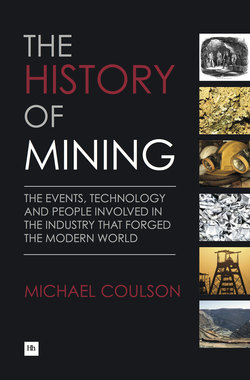Читать книгу The History of Mining - Michael Coulson - Страница 13
На сайте Литреса книга снята с продажи.
5. Early Mining in India
ОглавлениеOne of the interesting aspects of mining in India is the relatively early use of zinc, which meant that brass for coins, sculptures, images and other objects was being used quite widely before other ancient societies such as China and Greece made brass. Indeed, some Indian brass objects found have been dated as early as the 3rd century BC. One of the best-preserved zinc mining sites in India is Zawar in Rajasthan in Western India. There, shafts were found down to a depth of 300 feet and wooden residues indicate the use of ladders, supports and drainage conduits in the operations. The workings are thought to date back to the latter half of the 1st millennium BC and were linked to an advanced system of zinc smelting involving retorts and furnaces which produced a zinc vapour, which was then collected in vessels and condensed, leaving behind the contained zinc metal.
India’s historic mining and metallurgical expertise in copper, tin and thus bronze goes back even further to at least the 4th millennium BC. The ancient workings of Khetri and Rajpura-Dariba in the north west of the country demonstrate that sophisticated copper mining and smelting operations existed in ancient India. It is believed though that the tin used to make bronze did not come from the region itself but possibly from the centre of the country, or perhaps was imported from the rich tin areas of Malaya or Indonesia. It is thought that Indian expertise in copper may well have been introduced from Persia, and in support of this theory many copper and bronze articles have been found in the east of modern day Iran, in the north west of India and some in the south west of Afghanistan. Indeed, archaeological evidence indicates that there was a metal working site at Mundigak in Afghanistan and that techniques developed there, or perhaps developed further west, travelled down to the Indus Valley during the 3rd millennium BC.
The earliest bronze artefacts in India were found in the north west of the country in the Indus River Valley; these were largely weapons like knives and spears but also tools like axes and domestic items such as mirrors. In this we can see that technological progress was slow as the Bronze Age spread round the known world, so for thousands of years bronze technology was aimed primarily at manufacturing equipment for war. The artefacts are the clearest sign of a copper mining, alloying and smelting industry in this part of India, with remains of the ancient operations rather limited after so many centuries. It is therefore difficult to ascertain the likely levels of production of copper, but it would be a reasonable guess that annual output would have been in the hundreds of tonnes rather than anything more. Certainly in recent times a small-scale basic copper mining industry has operated in the Indus Valley area producing modest amounts of copper and this may well mirror the scale of the ancient mining. So the presence of small-scale copper mining today provides a link with much earlier operations in the Indus Valley.
Gold mining in the state of Karnataka, south west India, was carried out around the end of the 1st century BC where evidence of fire setting techniques from that era has been found at the operating Hutti gold mine, as well as evidence of charcoal for smelting and also gold residues. At about the same time – the end of the 1st century BC – a gold mine was established at Uti, near to Hutti. Around the 3rd century AD a number of small pits were dug to extract surface gold in Karnataka at Kolar and by the 9th century AD a larger operation had been developed there. Also in Karnataka state, the now-closed Ingaldhal copper mine in the Chitradurga district was first worked around the time of the establishment of the Hutti gold mine.
